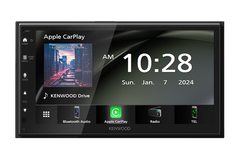Description
xApple CarPlay® – Connect via USB
A smarter, safer and more fun way to use your iPhone in the car. Apple CarPlay gives iPhone users an intuitive way to make calls, use Maps, and listen to music with just a word or a touch.
*Some features, applications, and services are not available in all areas.
Android Auto ™ – Connect via USB
Android Auto was designed with safety in mind. With larger touch targets, a split-screen interface, and easy-to-use voice actions, it's designed to minimize distraction so you can stay focused on the road.
*Compatible Android phone and compatible active data plan required.
*Some features and devices may not be available in all countries. Subject to availability.
USB Mirroring for Smartphone
By installing the "MirrorAPP+", your mobile phone is seamlessly displayed on the receiver's screen via USB. You can enjoy a variety of apps such as Waze, YouTube, and Instagram. Touch control is possible from both screen and smartphone.
Streaming Music
Listen to popular music applications and music stored on your device with basic audio controls.
Optimal Sound Performance with 13 Band Graphic EQ and Time Alignment
Use the graphic equalizer to tailor the sound quality to your unique tastes. Additional sound staging is available with the Time Alignment feature, designed to provide optimal sound performance.
Playable Video & Audio Files
You can play back from USB devices audio and video files compressed in various formats.
ENHANCED VEHICLE INTEGRATION
Enhance your vehicle integration with the iDatalink Maestro RR/RR2 (sold separately). This system allows you to retain your factory steering wheel audio controls, factory amplifier, and secondary displays. Additionally, it can display crucial vehicle information, such as performance data, climate controls, and battery voltage, when connected to compatible vehicles. For added convenience, radar detector information can be shown on the screen when paired with a compatible K40 radar detector system (sold separately). With the iDatalink Maestro RR2, you can also integrate an Escort radar detector system (sold separately) for a seamless driving experience.
Rear View Camera Input with Parking Guidelines
An optional rear view camera enhances safety while backing up and monitoring behind your vehicle. Built-in, adjustable parking guidelines further add to its effectiveness.
WSVGA LCD Display
The WSVGA display reproduces approximately 1.6 times higher resolution than the conventional WVGA display. You can enjoy finely detailed expression of color gradients and lifelike visuals in dramas and movies, enhancing your viewing experience.
Convenient and Easy-to-Use Capacitive Touch Panel
Provides a high contrast ratio, crystal clear display and vivid text. Easy to use widgets provide access to information screens with a swipe.
SiriusXM Radio Ready
Access additional music, sports and entertainment content on the go with SiriusXM Radio.(Optional SiriusXM tuner required, sold separately)
- 6.8" WSVGA Display with Capacitive Touch Panel
- Apple CarPlay® & Android Auto™ Ready
- USB Mirroring for iPhone / Android
- iDatalink Maestro Ready
- 13 Band EQ & Digital Time Alignment
- Rear View Camera Input with Parking Guidelines
- Built-in Bluetooth®
- 2 Preouts 3.7V & Subwoofer Out
- Short Chassis
Shipping & Return
xReturns Policy
You may return most new, unopened items within 30 days of delivery for a full refund. We'll also pay the return shipping costs if the return is a result of our error (you received an incorrect or defective item, etc.).
You should expect to receive your refund within four weeks of giving your package to the return shipper, however, in many cases you will receive a refund more quickly. This time period includes the transit time for us to receive your return from the shipper (5 to 10 business days), the time it takes us to process your return once we receive it (3 to 5 business days), and the time it takes your bank to process our refund request (5 to 10 business days).
If you need to return an item, simply login to your account, view the order using the "Complete Orders" link under the My Account menu and click the Return Item(s) button. We'll notify you via e-mail of your refund once we've received and processed the returned item.
Shipping
We can ship to virtually any address in the world. Note that there are restrictions on some products, and some products cannot be shipped to international destinations.
When you place an order, we will estimate shipping and delivery dates for you based on the availability of your items and the shipping options you choose. Depending on the shipping provider you choose, shipping date estimates may appear on the shipping quotes page.
Please also note that the shipping rates for many items we sell are weight-based. The weight of any such item can be found on its detail page. To reflect the policies of the shipping companies we use, all weights will be rounded up to the next full pound.
- Choosing a selection results in a full page refresh.









